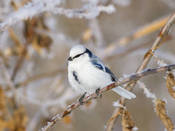search
Мастера на PROFI.RU:
| Ремонт квартир |
| Уборка квартир |
| Мастера по маникюру |
classification:
Gaviiformes
Podicipediformes
Pelecaniformes
Ciconiiformes
Phoenicopteriformes
Anseriformes
Falconiformes
Galliformes
Gruiformes
Charadriiformes
Pterocletiformes
Columbiformes
Cuculiformes
Strigiformes
Caprimulgiformes
Apodiformes
Coraciiformes
Upupiformes
Piciformes
Passeriformes
|
basic information
|
Azure Tit
Parus cyanus (Pallas, 1770)

|

|
|
|
2013-03-19
Eastern Kazakstan,Usti-Kamenogorsk .Komsomolskiy ostrov |
© Vladimir Shefer
|
|

Distribution
Breeds in Northern, Eastern and South-Eastern Kazakhstan. Please see detailed distribution in the section Subspecies.
Biology
Common, in places rare resident. Inhabits the deciduous and riparian forests, groves, gardens, and occasionally reed-beds with shrubs; the mixed and coniferous forests with shrubs undergrowth; both on plains and in mountains at altitudes up to 2500 m. On dispersal prefers the deciduous forests and groves. Breeds in separate pairs far one from another. Pairs are formed since mid-February. Nest is located in tree hole, in cavities of human constructions (readily nests in nest-boxes), in pile of old reeds; and even in Muskrat burrow; nest is built for about two week from the thin twigs, dry grass and moss and is lined with plenty of hair, feathers or cotton-wool. Generally nest is located low above the ground. Clutch of 4-9 eggs is laid in early May to early July; female incubates clutch for 13-14 days. Both parents feed juveniles which fledge in mid-June to early August. Though the breeding time is very long the number of reared per season broods is unknown. In August-September, as soon as moulting finishes the Azure Tits begin to disperse singly, in pairs or in groups up to 15-20 birds.
Subspecies
| Parus cyanus cyanus (Pallas, 1770) Description. Head is white. Mantle is darker, more bluish, less greyish-bluish; white on secondaries is less distributed than in hyperrhiphaeus. | |
 | Parus cyanus hyperrhiphaeus (Dementiev et Heptner, 1932) Description. Head is white. Mantle is lighter, more greyish-bluish, less bluish; white on secondaries more distributed than in cyanus. |
 | Parus cyanus yenisseensis (Buturlin, 1911) Description. Head is grey-tinged. mantle is lighter than in cyanus, but darker than in hyperrhiphaeus. White on secondaries distributed same as in cyanus. |
 | Parus cyanus koktalensis (Portenko, 1954) Description. Colour is similar to hyperrhiphaeus; differs by more massive bill. |
 | Parus cyanus tianschanicus (Menzbier, 1884) Description. Head is with intens grey tinge, darker than in yenisseensis. Mantle is the same as in cyanus, and darker than in yenisseensis and hyperrhiphaeus. White on secondaries is less distributed than in cyanus and yenisseensis. |
References
Gavrilov E. I., Gavrilov A. E. "The Birds of Kazakhstan". Almaty, 2005. Э.И.Гаврилов. "Фауна и распространение птиц Казахстана". Алматы, 1999. В.К.Рябицев. "Птицы Урала, Приуралья и Западной Сибири". Екатеринбург. Изд-во Уральского университета, 2000.
supplement
subspecies(Pallas, 1770)
(Dementiev et Heptner, 1932)
(Buturlin, 1911)
(Portenko, 1954)
(Menzbier, 1884)
hybrids
other names
go to family:












